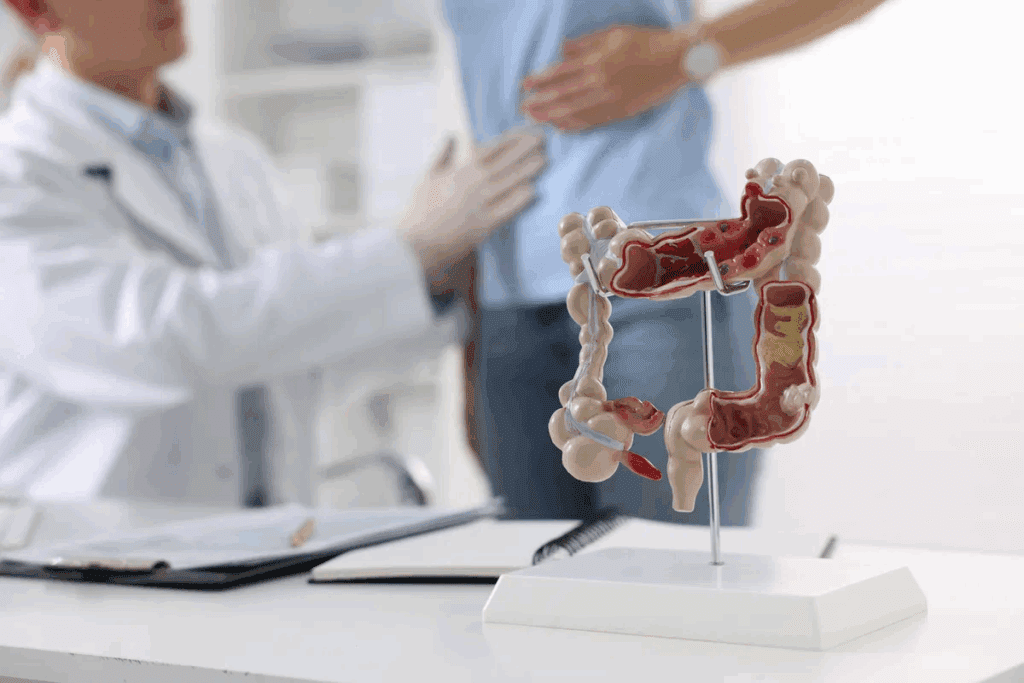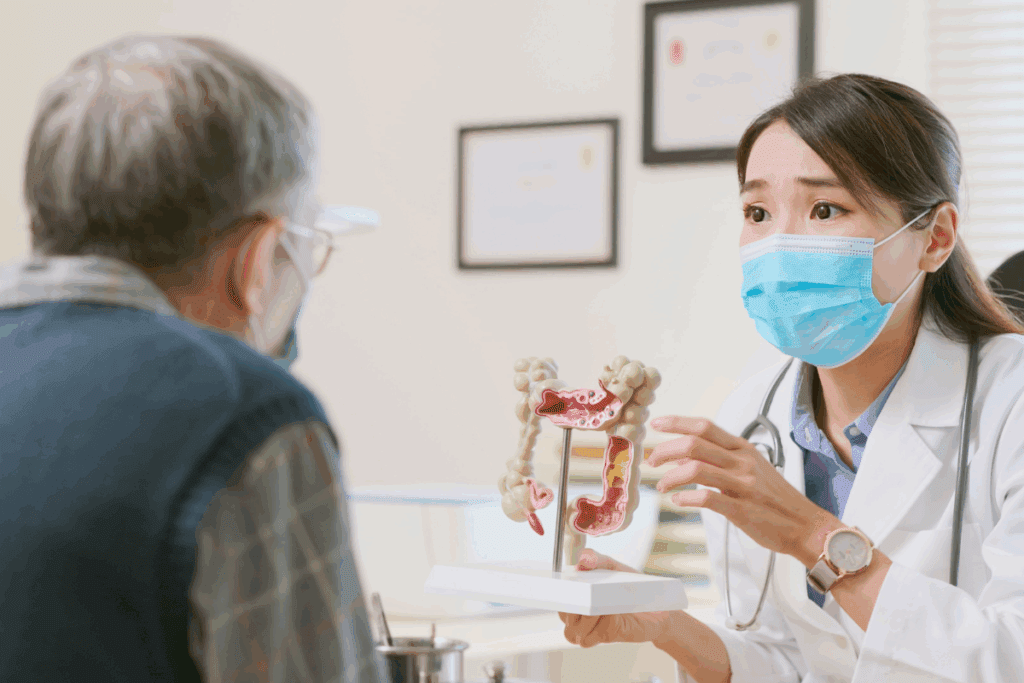Last Updated on November 26, 2025 by Bilal Hasdemir

The sigmoid colon is a key part of the large intestine. It plays a big role in our digestion. It’s found in the lower left part of our abdomen, between the descending colon and the rectum. Find out where is the sigmoid colon located, its anatomy, and associated cancer risk factors.
Knowing where the sigmoid colon is is important for health issues. Its S-shaped structure helps us understand the risks of sigmoid colon cancer.
Knowing the risks and taking steps to prevent them can lower the chance of getting colon cancer. Liv Hospital focuses on patient care for those with colon and sigmoid cancers.

Knowing about the colon’s anatomy is key to understanding its role in digestion. The colon, a part of the large intestine, absorbs water and stores feces. It’s about 5 feet long and has many important jobs in digestion.
The large intestine, or colon, has different sections for different jobs. It includes the cecum, ascending colon, transverse colon, descending colon, and sigmoid colon. The sigmoid colon is an S-shaped part that links the descending colon to the rectum.
The colon’s walls have layers like the mucosa, submucosa, muscularis, and serosa. The mucosa absorbs water and electrolytes. The muscularis layer has smooth muscle that moves waste through the colon.
The colon is key in digestion by absorbing water and electrolytes. This makes waste more concentrated and forms feces. It also has many microorganisms that help break down carbs and make vitamins.
“The colon’s role in water absorption and fecal storage is vital for maintaining normal bowel movements and preventing conditions such as constipation or diarrhea.”
The colon’s main functions are:
| Function | Description |
| Water Absorption | The colon absorbs water from the material that enters from the small intestine, helping to concentrate waste. |
| Fecal Storage | The colon stores fecal matter until it is eliminated from the body. |
| Electrolyte Absorption | The colon absorbs electrolytes, such as potassium and sodium, which are essential for various bodily functions. |
Understanding the colon’s anatomy and its role in digestion is key to grasping the risks of sigmoid colon cancer. Knowing how the colon works helps us see how cancer affects our health.

The sigmoid colon is a key part of the large intestine. It’s found in the lower left part of the abdomen. Knowing where it is helps us understand its role in digestion and how it works with other organs.
The sigmoid colon is in the lower left abdomen. It connects the descending colon to the rectum. Its S-shaped curve lets it fit in the pelvic area.
This anatomical position is important. It affects how the sigmoid colon works and its risk for problems.
The sigmoid colon starts at the iliac crest, where the descending colon ends. It goes until it meets the rectum at the third sacral vertebra. This shows its role as a link between the descending colon and the rectum.
The sigmoid colon is near many organs in the pelvic area. It’s close to the bladder in men and the uterus in women. It’s also near the ureters and blood vessels.
Knowing these relationships is key for diagnosing and treating problems with the sigmoid colon.
| Organ/Structure | Relation to Sigmoid Colon |
| Descending Colon | Precedes the sigmoid colon |
| Rectum | Follows the sigmoid colon |
| Bladder (in males) | Adjacent to the sigmoid colon |
| Uterus (in females) | Near the sigmoid colon |
| Ureters | Pass close to the sigmoid colon |
In conclusion, the sigmoid colon’s location is key for its function and how it interacts with other organs. Knowing its anatomical position and its relationships with other structures is important for diagnosing and treating problems.
It’s important to know how the sigmoid colon works for good digestive health. This part of the large intestine is key in the last steps of waste processing before it leaves the body.
The sigmoid colon has two main jobs. It stores fecal matter and absorbs water. These tasks help keep bowel movements regular and support overall digestive health.
The sigmoid colon holds fecal matter until it’s time to go. This is important for controlling when you go to the bathroom and preventing accidents.
The colon’s walls can stretch to hold different amounts of feces. This stretchiness helps you control when you go and prevents accidents.
The sigmoid colon also absorbs water and electrolytes. This makes the feces more solid and easier to pass.
The lining of the sigmoid colon has cells that help absorb water and electrolytes. This is key for keeping the body’s fluid balance and preventing dehydration.
The sigmoid colon works well to prevent constipation or diarrhea. If it doesn’t work right, it can cause discomfort. It might even lead to cancer in the sigmoid colon.
| Function | Description | Importance |
| Storage of Fecal Matter | The sigmoid colon acts as a reservoir for feces until elimination. | Crucial for controlling bowel movements. |
| Water Absorption | Absorption of water and electrolytes to concentrate fecal matter. | Essential for maintaining fluid balance and preventing dehydration. |
The sigmoid colon and the descending colon are often mixed up. But they are different in many ways. Knowing these differences helps doctors treat colon problems better.
The sigmoid colon and descending colon are both parts of the large intestine. But they are in different places and look different. The descending colon is in the left upper part of the abdomen and goes down to become the sigmoid colon. The sigmoid colon is an S-shaped part that links the descending colon to the rectum.
The sigmoid colon moves more than the descending colon. This is because it has a mesocolon, a tissue fold that attaches it to the back of the abdomen. This allows it to move more. The descending colon, on the other hand, stays in one place.
Both the sigmoid and descending colon help store and get rid of feces. But the sigmoid colon’s main job is to hold feces until they are ready to go. Its S-shape helps it keep feces until it’s time to pass them.
When it comes to water absorption, both parts help. But the sigmoid colon is better at absorbing water and salts. This is because it has thicker muscles and more mucosal folds.
It’s important to know these differences to diagnose and treat problems like descending colon cancer and sigmoid colon cancer. Each part has its own risks and symptoms. Knowing the difference is key to treating them right.
Cancer in the sigmoid colon can take several forms, mainly adenocarcinoma. The sigmoid colon, a part of the large intestine, is prone to different types of cancer. Knowing these types is key for diagnosis and treatment.
Adenocarcinoma is the most common cancer in the sigmoid colon. It starts from glandular cells in the colon. This cancer is aggressive and can spread to other parts of the body.
Characteristics of Adenocarcinoma:
While adenocarcinoma is the most common, other cancers can also occur in the sigmoid colon. These include:
These cancers are less common but important. Their treatment can be different from adenocarcinoma.
| Cancer Type | Origin | Characteristics |
| Adenocarcinoma | Glandular epithelial cells | Aggressive, can spread |
| Lymphoma | Lymphoid cells | Can vary, aggressive |
| Sarcoma | Connective tissue | Rare, very malignant |
| Carcinoid Tumors | Neuroendocrine cells | Slow-growing, can make hormones |
It’s important to know the different types of sigmoid colon cancer. Each type has its own traits and how it might affect treatment.
Sigmoid colon malignancy is a big health issue worldwide. It affects different people in different ways. It’s a big problem for health care systems everywhere.
“The global burden of colorectal cancer is substantial, with an estimated 1.8 million new cases and over 880,000 deaths annually,” a report says. This shows why we need to know more about sigmoid colon malignancy.
The rate of sigmoid colon cancer changes a lot in different places and groups. In the U.S., it’s one of the top cancers. The American Cancer Society says there were about 106,180 new cases of colon cancer in 2023.
Worldwide, many things affect how common sigmoid colon cancer is. These include diet, lifestyle, and genes. High-income countries tend to have higher rates, possibly because of diet and less exercise.
Who gets sigmoid colon cancer varies. Most cases happen in people over 50. There are also differences in who gets it based on gender and ethnicity.
Knowing who gets it helps in making better screening and prevention plans. Dr. Jane Smith, a top oncologist, says, “Early detection is key to improving survival rates in sigmoid colon cancer patients.”
By looking at how common sigmoid colon malignancy is, doctors and researchers can learn more. They can then work on better ways to prevent, find early, and treat it.
It’s important to know the symptoms of sigmoid colon cancer early. This type of cancer in the colon often shows signs that are not obvious. These signs can be mistaken for other health issues.
Look out for changes in your bowel habits, like constipation or diarrhea. You might also feel pain or discomfort in your abdomen. Rectal bleeding is a symptom that should not be ignored.
A study in the Journal of Clinical Oncology found that people with this cancer often notice:
“…persistent changes in bowel habits, including diarrhea or constipation, or a feeling of incomplete evacuation of the bowel.”
As the cancer grows, symptoms can get worse. You might feel:
See a doctor if you have any of these symptoms:
| Symptom | Description |
| Persistent abdominal pain | Lasting more than a few days |
| Rectal bleeding | Bleeding that is persistent or accompanied by other symptoms |
| Unexplained weight loss | Significant weight loss without changes in diet or exercise |
Spotting sigmoid colon cancer early can lead to better treatment. If you notice any symptoms or have concerns, talk to a healthcare professional.
The sigmoid colon is more likely to get cancer due to several risk factors. These can be divided into genetic, lifestyle, and medical conditions.
Genetics are a big factor in sigmoid colon cancer. If your family has a history of colorectal cancer, you’re at higher risk. This risk is even higher if a family member got cancer when they were young.
Certain genetic syndromes like Lynch syndrome and familial adenomatous polyposis (FAP) also raise the risk. These conditions make you more likely to get colorectal cancer, including in the sigmoid colon.
Genetic testing can spot these syndromes early. This allows for early action and monitoring.
“The presence of a genetic syndrome such as Lynch syndrome or FAP necessitates a proactive approach to colorectal cancer screening and prevention.” –
A leading gastroenterologist
Lifestyle and environment also play a part in sigmoid colon cancer risk. Eating a lot of red and processed meats, and not enough fiber, can up your risk. Being inactive, overweight, and smoking also increase your risk.
Some medical conditions can also raise your risk of sigmoid colon cancer. Inflammatory bowel diseases (IBD) like ulcerative colitis and Crohn’s disease can cause chronic inflammation. This can increase your risk of colorectal cancer.
| Medical Condition | Risk Level |
| Ulcerative Colitis | High |
| Crohn’s Disease | High |
| Type 2 Diabetes | Moderate |
Regular screening and monitoring are key for people with these conditions. This helps catch any problems early.
Sigmoid colon masses are diagnosed using several methods. These include imaging, endoscopic exams, and biomarker tests. This approach helps find and understand sigmoid colon cancer well.
Imaging is key in finding sigmoid colon masses. Computed Tomography (CT) scans give detailed views of the colon and nearby areas. CT colonography, or virtual colonoscopy, lets doctors see the colon without a traditional colonoscopy.
Magnetic Resonance Imaging (MRI) helps see how far a tumor has spread. It checks for cancer in lymph nodes or other parts of the body. Positron Emission Tomography (PET) scans spot cancer cells that are active, helping find tumors and their spread.
Endoscopy is vital for seeing the sigmoid colon and getting tissue samples. Colonoscopy is the best way to find and biopsy tumors. Flexible sigmoidoscopy looks at the sigmoid colon but not the whole colon.
Narrow-band imaging (NBI) and other advanced methods help see tumors better. They show more about the mucosa and blood vessels.
Laboratory tests help diagnose and monitor sigmoid colon cancer. Fecal occult blood tests (FOBT) and carcinoembryonic antigen (CEA) tests are used. High CEA levels suggest colorectal cancer, including sigmoid colon tumors.
Molecular tests for KRAS and BRAF mutations guide treatment. They give important info for treatment plans.
Treatment for sigmoid colon cancer often includes surgery, chemotherapy, and radiation therapy. Each treatment is chosen based on the cancer’s stage, the patient’s health, and other factors.
Surgery is a key treatment for sigmoid colon cancer. The goal is to remove the cancer and nearby lymph nodes. Surgical resection is common, where the affected colon part is removed and the healthy tissue is connected.
In some cases, minimally invasive surgery is an option. It uses smaller incisions and may have less recovery time. But, it depends on the case and the surgeon’s skill.
Chemotherapy kills cancer cells that may have spread. It can be given before or after surgery. Adjuvant chemotherapy is used to lower the chance of cancer coming back.
The type of chemotherapy drugs and how long treatment lasts vary. It depends on the cancer’s stage and the patient’s health. Common drugs include fluorouracil and oxaliplatin.
Radiation therapy kills cancer cells with high-energy rays. It’s often used with chemotherapy and surgery. External beam radiation therapy is common, where rays come from outside the body.
Internal radiation therapy (brachytherapy) is sometimes used. A small radioactive material is placed near the tumor.
New treatments and clinical trials are being explored for sigmoid colon cancer. These include targeted therapy and immunotherapy. They aim to improve treatment outcomes.
Patients may be eligible for clinical trials. These trials offer access to new treatments. It’s important to talk to a healthcare provider about these options.
| Treatment Option | Description | Benefits |
| Surgical Resection | Removing the cancerous portion of the colon | Potential cure, removal of tumor |
| Chemotherapy | Killing cancer cells with drugs | Reduces risk of recurrence, treats spread |
| Radiation Therapy | Killing cancer cells with radiation | Shrinks tumor, kills remaining cells |
Knowing where and how the sigmoid colon works is key to keeping it healthy. It’s a big part of our digestive system. Its health affects our overall well-being.
Colon cancer in the sigmoid colon is a serious issue. Knowing the risks, symptoms, and how to diagnose it early is important. By focusing on sigmoid colon health and preventing colon cancer, we can lower our risk.
Living a healthy lifestyle helps a lot. Eating right and exercising regularly keeps the colon healthy. Also, regular health checks and screenings can catch problems early. This means we can treat them quickly.
The sigmoid colon is in the lower left part of the abdomen. It’s an S-shaped part of the large intestine.
The sigmoid colon stores fecal matter and absorbs water. This helps with bowel movements and digestive health.
The sigmoid colon is curved like an S. The descending colon is straighter and comes before the sigmoid. They are different in shape and function.
Adenocarcinoma is the most common cancer in the sigmoid colon. It’s a type of malignant tumor.
Symptoms include changes in bowel habits, abdominal pain, blood in stool, and weight loss. Seeing a doctor is important if these symptoms last.
Risk factors include genetic predispositions, lifestyle, and certain medical conditions. Knowing these can help prevent and detect cancer early.
Doctors use imaging, endoscopy, and lab tests to diagnose. These tools help find and diagnose cancer in the sigmoid colon.
Treatments include surgery, chemotherapy, and radiation. New treatments and trials are also available.
While some risks can’t be changed, a healthy lifestyle and regular check-ups help. Being aware of risks is key to prevention.
Sigmoid colon cancer is a big health problem worldwide. Knowing its prevalence helps tackle it.
The sigmoid colon is near the rectum and other digestive parts. Knowing this helps diagnose and treat related issues.
Ljubičić, N., et al. (2015). Biliary leakage after urgent cholecystectomy. Journal of Hepato-Biliary-Pancreatic Sciences. Retrieved from https://pmc.ncbi.nlm.nih.gov/articles/PMC4436923
Subscribe to our e-newsletter to stay informed about the latest innovations in the world of health and exclusive offers!